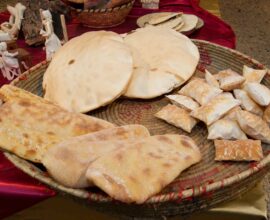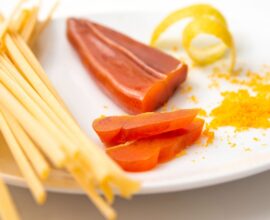Frègula, a symbol of Sardinian gastronomy
What is Sardinian frègula and how is it prepared?
Frègula is a particular type of pasta handcrafted in Sardinia and highly appreciated for its great versatility. In fact, people use it for tasty first courses based on meat, fish or vegetables.
Among the many typical dishes of the Sardinian gastronomic tradition, the frègula undoubtedly occupies a place of honor. Indeed, this pasta – often mistakenly called fregola, and also known as fregua, succu, cascà or pistitzone, depending on the place – is a symbol of island cuisine.
The origin of the name would seem to derive from the Latin ferculum, meaning “crumb”, referring to the size and texture that is very reminiscent of couscous. However, the couscous grains are smaller than those of this typical Sardinian pasta. Also, the main difference between the two is the cooking method. In fact, frègula is cooked in boiling water, in meat broth or as a risotto, while couscous is simply rehydrated with hot water.
Frègula is a very ancient type of pasta. It is made with three simple ingredients: durum wheat semolina, water and salt. The small irregular amber-colored grains, with a diameter varying between 2 and 6 millimeters, are obtained by “rolling”, ie by mixing durum wheat semolina and water by hand and for a long time in a large earthenware container. Who prepares the frègula works the semolina with their fingertips, turning it until it become a sandy mixture, which then they let it rest for a few minutes.
It is the circular movement of the hands that creates the frègula which is then dried in the sun on a basket covered with a cloth. Once dry, it is transferred to large baking sheets and toasted in the oven at about 150 ° C for 15 to 30 minutes, depending on the size of the grains. Indeed, the larger they are, the longer the roasting time will be. Finally, the frègula is let to cool and then used to prepare dishes.
A particularly popular variant of frègula mixes a small amount of saffron with durum wheat semolina. Instead, another version with the addition of the egg is typical of the eastern part of the island.
3 dishes with Sardinian frègula
The first evidence of the existence of frègula dates back to the 14th century. In fact, the typical Sardinian pasta is mentioned in the Statute of the Millers of the Tempio Pausania area, where it is read that sa fregula could only be processed from Monday to Friday since on Saturday and Sunday the water was to be used only to irrigate the fields.
Frègula is a very versatile pasta, perfect for different preparations. For example, you can use it to make first courses with meat, fish or vegetables. Some of the typical dishes are:
- Frègula with clams: it is a very tasty and delicious first course that you can prepare with or without tomato sauce. In Cagliari dialect it takes the name of frègula cun còcciulas;
- Frègula with mussels: it is one of the most popular preparations of Sardinian cuisine, as it has all the flavor of the sea;
- Frègula risottata: it is a very simple but extremely tasty dish. You have to cook the pasta in the meat or fish broth.
You can also use frègula to create fresh, light and tasty dishes, such as delicious salads dressed with extra virgin olive oil, salt and lemon.
In short, this typical product of Sardinia can never be missing in the pantry of those who love the authentic flavors of island cuisine. It is something you should discover and taste. And it is no coincidence that today it is becoming popular even outside of Sardinia. In fact, great Italian and foreign chefs are using it for preparing gourmet dishes, such as those you can find at the restaurants of the Forte Village Resort in Santa Margherita di Pula, near Cagliari.
Forte Village is the accessible luxury resort, on the white and sunny Sardinian southern coast. Surrounded by the scents of the Mediterranean scrub, it offers a wide range of restaurants for all tastes, where you can discover the delicacies of renowned chefs, such as Heinz Beck, winner of 3 Michelin stars. But guests can also try the dishes of the Italian regional cuisine and those of the Sardinian tradition. They are all prepared with simple and genuine ingredients that tell the different souls of ancient Ichnusa.
And the mix of aromas and flavors is made even more unique thanks to the combination with the best Sardinian wines, such as Cannonau and Vermentino, which are the result of the passion for the land of this gorgeous island.
Do you want to discover the authentic flavors of Sardinian cuisine and live a dream vacation in a true paradise? Discover the Forte Village Resort in Sardinia






